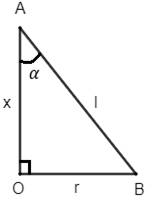The height of a cone increases by k%, its semi-vertical angle remaining the same. What is the approximate percentage increase in (i) in total surface area, and (ii) in the volume, assuming that k is small.
Given the height of a cone increases by k%.
Let x be the height of the cone and Δx be the change in the value of x.
Hence, we have![]()
∴ Δx = 0.01kx
Let us assume the radius, the slant height and the semi-vertical angle of the cone to be r, l and α respectively as shown in the figure below.

From the above figure, using trigonometry, we have
![]()
![]()
∴ r = x tan(α)
We also have
![]()
![]()
![]()
∴ l = x sec(α)
(i) The total surface area of the cone is given by
S = πr2 + πrl
From above, we have r = x tan(α) and l = x sec(α).
⇒ S = π(x tan(α))2 + π(x tan(α))(x sec(α))
⇒ S = πx2tan2α + πx2tan(α)sec(α)
⇒ S = πx2tan(α)[tan(α) + sec(α)]
On differentiating S with respect to x, we get
![]()
![]()
We know![]()
![]()
![]()
Recall that if y = f(x) and Δx is a small increment in x, then the corresponding increment in y, Δy = f(x + Δx) – f(x), is approximately given as
![]()
Here, ![]() and Δx = 0.01kx
and Δx = 0.01kx
⇒ ΔS = (2πxtan(α)[tan(α) + sec(α)])(0.01kx)
∴ ΔS = 0.02kπx2tan(α)[tan(α) + sec(α)]
The percentage increase in S is,
![]()
![]()
⇒ Increase = 0.02k × 100%
∴ Increase = 2k%
Thus, the approximate increase in the total surface area of the cone is 2k%.
(ii) The volume of the cone is given by
![]()
From above, we have r = x tan(α).
![]()
![]()
![]()
On differentiating V with respect to x, we get
![]()
![]()
We know![]()
![]()
![]()
Recall that if y = f(x) and Δx is a small increment in x, then the corresponding increment in y, Δy = f(x + Δx) – f(x), is approximately given as
![]()
Here, ![]() and Δx = 0.01kx
and Δx = 0.01kx
⇒ ΔV = (πx2tan2α)(0.01kx)
∴ ΔV = 0.01kπx3tan2α
The percentage increase in V is,
![]()


⇒ Increase = 0.03k × 100%
∴ Increase = 3k%
Thus, the approximate increase in the volume of the cone is 3k%.